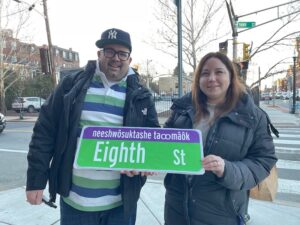Who is a member?
Our members are the local governments of Massachusetts and their elected and appointed leadership.

David Shane Lowry, left, and Sage Carbone, members of an advisory group helping Cambridge improve the visibility of Indigenous languages and history, hold up prototypes for bilingual street signs that will go up in the city’s eastern end.
As it seeks to acknowledge its Indigenous past and present, the city of Cambridge will soon install bilingual street signs translated in the Massachusett language on several streets in the eastern part of town.
By March, the city hopes to erect 70 to 80 new street signs on First through Eighth streets as part of the African American and Indigenous Peoples Historical Reckoning Project, which has received $180,000 through Cambridge’s participatory budgeting process to recognize local Indigenous history through the street signs and other projects, and to repair and enhance the city’s Black historical markers.
Though Indigenous-language signs are more common on reservations, Cambridge may be one of the first municipalities to have them in this state, if not the country, according to people involved in the project. The project’s organizers said they hope the Indigenous street signs will encourage greater awareness of local tribal history and of current Native American residents, and that the increased awareness will lead to more projects and programming centered around Indigenous history and culture.
“The city of Cambridge is very committed to acknowledging the diversity in our community, and to equity and inclusion efforts,” said Sarah Burks, a preservation planner for the Historical Commission. “This is something that the citizens of Cambridge voted for, and it’s something they wanted to fund, so the city staff are committed to seeing it through.”
Resident Sage Carbone, a descendant of the Massachusett Indian Tribe and a member of the Northern Narragansett Indian Tribe of Rhode Island, proposed the idea in 2021 through the city’s participatory budgeting process, in which residents vote on funding for one-time capital projects. Ultimately, her proposal was combined with a proposal to restore and improve Cambridge’s Black historical markers. Work on the Black historical markers has started, Burks said, but the city is trying to hire a new staff member to move that project forward.
The Indigenous project reflects a heritage that has always existed, but was not always acknowledged. In the first state to receive an Indigenous name (Massachusetts translates to “great-hill-small-place”), Indigenous peoples lived in an area called Anmoughcawgen, which means either “fishing weir” or “beaver dam.” After European colonization, the area became known as Newtowne, and later Cambridge.
In proposing the translated signs, Carbone said she was inspired by seeing Indigenous-language signs on reservations, and was motivated by the lack of Indigenous representation in diversity programming and initiatives.
“If the city wants to increase the visibility of Indigenous peoples and languages, this is an economical way to do it,” Carbone said. “A street sign is not a huge investment. What the investment is — is opening up a relationship with the tribal nations that are in your area, and having a conversation about it.”
Working with the Historical Commission and city staff, an advisory group composed of Carbone, David Shane Lowry and Elizabeth Solomon invited scholars, leaders and language keepers from tribes in New England. The group selected the Massachusett language, since the Massachusett people lived in the area, and their language closely resembles other locally spoken Indigenous languages. Translators from the Massachusett tribe at Ponkapoag provided the translations.
The group started with the numbered streets in East Cambridge because those words would be the easiest to translate. They also approved a design containing the standard green background and white lettering for the official street name, with a purple strip along the top bearing the translated name in white letters.
At some major intersections, additional, smaller signs placed lower on the poles will direct people to a website with background on the project, information about the Massachusett language and history, and audio pronunciations of the translated street names.
After completing the initial phase, the group will look at other ways to increase Indigenous visibility in Cambridge. Carbone wants the project to inspire other cities and towns.
“That’s the major hope,” Carbone said, “is that municipalities will be more open to relationships with tribal nations.”